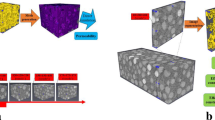Abstract
A comparative study of various idealized models for geometric structure of highly porous cellular materials is carried out. The study is based on statistical parameters describing the geometric structure of these materials. A tetrakis dodecahedron model is chosen as the closest to the geometry of cells of highly porous cellular material and relatively simple for creation of physical and functional models of the material.
Similar content being viewed by others
References
Tikhomirov, V.K., Peny. Teoriya i praktika ikh polucheniya i razrusheniya (Foams. Theory and Practice of Their Formation and Decomposition), Moscow: Mir, 1985.
Hudson, D., Statistics for Physicists Geneva,: CERN, 1964; Moscow: Mir, 1970.
Thomson, W., On the division of space with minimum partitional area, Acta Mathem., 1887, vol. 11, pp. 121–134.
Rivier, N., Seifenblasenrhetorik, or the sound of the last trumpet, Forma, 1996, vol. 11, pp. 195–198.
Weaire, D. and Phelan, R., A counter-example to Kelvin’s conjecture on minimal surfaces, Philos. Mag. Lett., 1994, vol. 69, pp. 107–110.
Kusner, R. and Sullivan, J.M., Comparing the Weaire- Phelan equal-volume foam to Kelvin’s foam, Forma, 1996, vol. 11, pp. 233–242.
Aboav, D.A., Kelvin’s “division of space”, and its aftermath, Forma, 1996, vol. 11, pp. 243–254.
Phelan, R., Generalisations of the Kelvin problem and other minimal problems, Forma, 1996, vol. 11, pp. 287–302.
Honda, H., Morita, T., and Tanabe, A., Establishment of epidermal cell columns in mammalian skin: Computer simulation, J. Theor. Biology, 1979, vol. 81, pp. 745–759.
Gabbrielli, R., A new counter-example to Kelvin’s conjecture on minimal surfaces, Philos. Mag. Lett., 2009, vol. 89, pp. 483–491.
Krishnan, S., Murthy, J.Y., and Garimella, S.V., Direct simulation of transport in open-cell metal foam, J. Heat Transfer, 2006, vol. 28, pp. 793–800.
Matzke, E.B., The three-dimensional shape of bubbles in foam–an analysis of the role of surface forces in three-dimensional cell shape determination, Am. J. Botany, 1946, vol. 33, pp. 58–80.
Dai, Z., Nawaz, K., Park, Y.G., Bock, J., and Jacobi, A.M., Correcting and extending the Boomsma-Poulikakos effective thermal conductivity model for three-dimensional, fluid-saturated metal foams, Int. Commun. Heat Mass Transfer, 2010, vol. 37, pp. 575–580.
Mahjoob, S. and Vafai, K., A synthesis of fluid and thermal transport models for metal foam heat exchangers, Int. J. Heat Mass Transfer, 2008, vol. 51, pp. 3701–3711.
Mechanics of Cellular Plastics, Ed. by Hilyard, N.C., London: Appl. Sci., 1982; Moscow: Mir, 1985.
Dement’ev, A.G. and Tarakanov, O.G., Struktura i svoistva penoplastov (Structure and Properties of Foam Plastics), Moscow: Khimiya, 1983.
Danchenko, Yu.V., High-porous penetrable cellular materials for cooled telescopic laser mirrors, Candidate’s (Eng.) Dissertation, Perm’, 1986.
Apollonov, V.V., Granovskii, M.S., Danchenko, Yu.V., et al., Hogh-porous materials on laser optic. Problems and Prospects, in Kvantovaya radiofizika (Quantum Radiophysics), Preprint of Inst. General Physics of Acad. Sci. USSR, Moscow, 1988.
Hagen, G., Information and Self-organization. Macroscopic Approach to Complex Systems Berlin: Springer- Verlag, 1988; Moscow: Mir, 1991.
Author information
Authors and Affiliations
Corresponding author
Additional information
Original Russian Text © A.A. Makarov, 2016, published in Materialovedenie, 2016, No. 2, pp. 23–28.
Rights and permissions
About this article
Cite this article
Makarov, A.A. Highly porous cellular materials: A statistical model of geometric structure. Inorg. Mater. Appl. Res. 7, 576–581 (2016). https://doi.org/10.1134/S2075113316040213
Received:
Published:
Issue Date:
DOI: https://doi.org/10.1134/S2075113316040213




